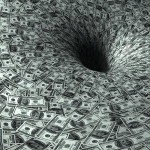Trading Derivative Instruments II
This lesson will cover the following
- Forward contracts and their features
- Options contracts and basic terms related to them
- Swaps contracts and currency swaps
Now let us continue with the explanation of several other kinds of derivatives, such as forwards, options and swaps.
Forward contracts
Fundamentally, forward and futures contracts have the same function: both types of contracts allow people to buy or sell a specific type of asset at a specific time in the future at a given price. However, unlike the future contracts, forward contracts, are private agreements between two parties and are not as rigid in their stated terms and conditions.

Forward contracts have the following characteristics:
- Commercial banks provide forward contracts.
- Forward contracts are not-standardized. This characteristic indicates that you can have a forward contract for any amount of money, such as buying $154,280.72 (as opposed to being able to buy only in multiples of $100,000).
- Forward contracts imply an obligation to buy or sell currency at the specified exchange rate, at the specified time, and in the specified amount, as indicated in the contract.
- Forward contracts are not tradable.
Forward contracts trade in the over-the-counter market. They do not trade on an exchange such as the NYSE, NYMEX, or CME. When a forward contract expires, the transaction is settled in one of the following two ways. The first way is through a process known as “delivery.” Under this type of settlement, the party that is long the forward contract position will pay the party that is short the position when the asset is delivered and the transaction is finalized. While the transactional concept of “delivery” is simple to understand, the implementation of delivering the underlying asset may be very difficult for the party holding the short position. As a result, a forward contract can also be completed through a process known as “cash settlement.”
Who would use forward contracts? The non-standardized and obligatory characteristics of forward contracts work well for export-import firms because they deal with any specific amount of account receivables or payables in foreign currency.
Forward contracts define one type of derivative instrument. For most investors, the derivative instrument concept is hard to understand. However, since derivatives are typically used by governmental agencies, banking institutions, asset management firms and other types of corporations to manage their investment risks, it is important for investors to have a general knowledge of what these instruments represent and how they are used by investment professionals.
Options
An option represents a contract that gives its buyer the right, but not the obligation, to purchase or sell an underlying asset (a stock, a commodity, a currency pair or an index) at a specific price on or before a certain date. It is a contract with strictly defined terms and properties.
An option is simply a contract tightly related to the underlying asset. For this reason, options are called derivative instruments, which means that they derive their value from the value of the underlying (base) asset.
Plain vanilla options (standard options), traded on options exchanges, have several features: maturity or expiration period, exercise (strike) price and class (call options and put options).
An exercise (strike) price is the price, at which the option holder can exercise his/her right to purchase or sell the base asset.
Options, which belong to one and the same class and have equal expiration period (maturity) are said to belong to one and the same series.
A call option provides the holder with the right to purchase an underlying asset at the strike price within a specific period of time (maturity). Call options are similar to holding a long position in a currency pair, a stock, or a commodity. Buyers of call options hope that the value of the currency pair (price of the stock) will increase before the option expires.
The buyer can always let the expiration date pass, at which point the option itself becomes worthless. In this case, he loses 100% of his investment (the money he paid buying the option).
A put option provides the holder with the right to sell an underlying asset at the strike price within a specific period of time (maturity). Put options are similar to holding a short position in a currency pair, a stock, or a commodity. Buyers of put options hope that the value of the currency pair (price of the stock) will decline before the option expires.
When trading options, individuals who purchase options are known as holders, while individuals who sell options are known as writers.
It is extremely important that we clarify the following circumstance.
Call option holders and put option holders (or buyers) do not have an obligation to buy or sell the base asset. They have only the choice whether to exercise their rights or not. Call option writers and put option writers (or sellers), on the other hand, have only the obligation to purchase or sell the base asset. This means that they may be required to make good on a promise to purchase or sell.
 When we refer to call options, these options are said to be in-the-money, in case the price of a share (value of a currency pair) exceeds the strike price. This means that we can make money, trading such an option. When we refer to put options, these options are said to be in-the-money, when the price of a share (value of a currency pair) remains below the strike price.
When we refer to call options, these options are said to be in-the-money, in case the price of a share (value of a currency pair) exceeds the strike price. This means that we can make money, trading such an option. When we refer to put options, these options are said to be in-the-money, when the price of a share (value of a currency pair) remains below the strike price.
The amount by which an option is in-the-money is referred to options intrinsic value. An option can be deep-in-the-money, or highly gaining and is unlikely to provide us with a loss.
In case, the price of a share (value of a currency pair) matches the strike price, options are said to be at-the-money.
 When we refer to call options, in case the price of a share (value of a currency pair) remains below the strike price, these options are said to be out-of-the-money. This means that it is not profitable to take action (exercise our rights), because we would lose money. When we refer to put options, in case the price of a share (value of a currency pair) exceeds the strike price, these options are said to be out-of-the-money. An option can be deep-out-of-the-money, or providing a large loss and is unlikely to become a gainer.
When we refer to call options, in case the price of a share (value of a currency pair) remains below the strike price, these options are said to be out-of-the-money. This means that it is not profitable to take action (exercise our rights), because we would lose money. When we refer to put options, in case the price of a share (value of a currency pair) exceeds the strike price, these options are said to be out-of-the-money. An option can be deep-out-of-the-money, or providing a large loss and is unlikely to become a gainer.
Options can be also distinguished as European and American options. European options can be exercised only at maturity. American options can be exercised at any time.
An option that is traded on a national options exchange such as the Chicago Board Options Exchange (CBOE) is known as a listed option. These options have fixed strike prices and expiration dates. Each listed option represents 100 shares of a company stock, which actually refers to as an option contract.
The total price of an option is known as a premium. It usually depends on a number of factors such as price of the underlying asset, exercise (strike) price, the period of time remaining before maturity (also known as time value) and volatility.
Why do investors use options? First of all, to speculate. We have already discussed the matter of speculating in the markets. Options are considered risky exactlly because of the fact they can be used when speculating. If a trader purchases an option, he/she needs to be precise not only in determining the direction of the price movement (in stocks or currency pairs), but also the extent and the timing of this movement. The trader should correctly project not only whether the price of the underlying asset will increase or decline, but also to what extent the price will change and in what period of time this could occur.
Another reason to use options in order to speculate in the markets is, of course, the ability to use leverage. In case a trader holds 1 contract, representing 100 shares, for example, he/she could register a considerable profit without the price moving quite much.
And second, options can be used in order to hedge. In this case traders use options to safeguard their positions against a possible downturn. If a trader intends to take advantage of a company stock, which has a potential to increase, he will be also willing to secure his investment against downside risks.
Swaps
A swap is a derivative instrument, with the use of which counter parties exchange cash flows of one partys financial instrument for cash flows of the other partys financial instrument. The two parties reach an agreement to exchange one stream of cash flows against another stream, with these streams being known as the legs of the swap. The swap agreement determines the dates, when the cash flows are due to be paid and the way they are estimated.
When we talk about a currency swap, we mean exchanging principal and fixed rate interest payments on a loan in one currency for principal and fixed rate interest payments on an equal loan in another currency. These swaps are stressing on comparative advantage. Currency swaps encompass swapping both principal and interest between the parties, with the cash flows in one direction being denominated in a different currency than cash flows in the opposite direction.
There are also other varieties of swaps, but as swaps trading has its specific features, it is a subject, that remains outside this tutorial.